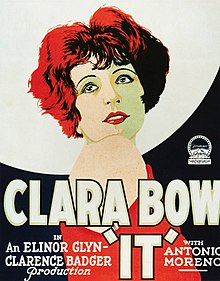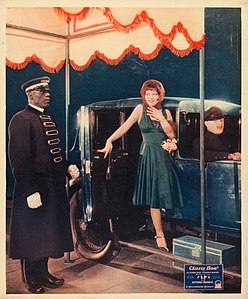
Wings is a 1927 American silent and synchronized sound film known for winning the first Academy Award for Best Picture. Due to the general public's apathy towards silent films, the film was quickly re-released in 1928 with synchronized sound. While the sound version of the film has no audible dialog, it was released with a synchronized musical score with sound effects. The film stars Clara Bow, Charles "Buddy" Rogers, and Richard Arlen. Rogers and Arlen portray World War I combat pilots in a romantic rivalry over a woman. It was produced by Lucien Hubbard, directed by William A. Wellman, and released by Paramount Famous Lasky Corporation. Gary Cooper appears in a small role, which helped launch his career in Hollywood.

The Docks of New York is a 1928 American silent drama film directed by Josef von Sternberg and starring George Bancroft, Betty Compson, and Olga Baclanova. The movie was adapted by Jules Furthman from the John Monk Saunders story The Dock Walloper.
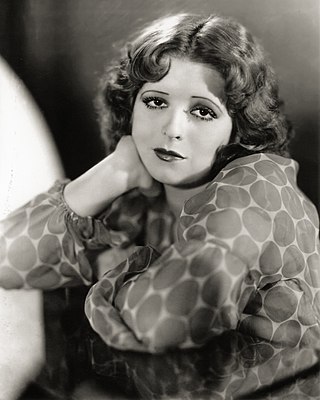
Clara Gordon Bow was an American actress who rose to stardom during the silent film era of the 1920s and successfully made the transition to "talkies" in 1929. Her appearance as a plucky shopgirl in the film It brought her global fame and the nickname "The It Girl". Bow came to personify the Roaring Twenties and is described as its leading sex symbol.

Fleischer Studios was an American animation studio founded in 1929 by brothers Max and Dave Fleischer, who ran the pioneering company from its inception until its acquisition by Paramount Pictures, the parent company and the distributor of its films. In its prime, Fleischer Studios was a premier producer of animated cartoons for theaters, with Walt Disney Productions being its chief competitor in the 1930s.

Betty Boop is an animated cartoon character designed by Grim Natwick at the request of Max Fleischer. She originally appeared in the Talkartoon and Betty Boop film series, which were produced by Fleischer Studios and released by Paramount Pictures. She was featured in 90 theatrical cartoons between 1930 and 1939. She has also been featured in comic strips and mass merchandising.

Clara Lou "Ann" Sheridan was an American actress and singer. She is best known for her roles in the films San Quentin (1937) with Humphrey Bogart, Angels with Dirty Faces (1938) with James Cagney and Bogart, They Drive by Night (1940) with George Raft and Bogart, City for Conquest (1940) with Cagney and Elia Kazan, The Man Who Came to Dinner (1942) with Bette Davis, Kings Row (1942) with Ronald Reagan, Nora Prentiss (1947), and I Was a Male War Bride (1949) with Cary Grant.

Elinor Glyn was a British novelist and scriptwriter who specialised in romantic fiction, which was considered scandalous for its time, although her works are relatively tame by modern standards. She popularized the concept of the it-girl, and had tremendous influence on early 20th-century popular culture and, possibly, on the careers of notable Hollywood stars such as Rudolph Valentino, Gloria Swanson and, especially, Clara Bow.

Luis Antonio Dámaso de Alonso, known professionally as Gilbert Roland, was a Mexican-born American film and television actor whose career spanned seven decades from the 1920s until the 1980s. He was twice nominated for the Golden Globe Award in 1952 and 1964 and inducted into the Hollywood Walk of Fame in 1960.

The Cat's Meow is a 2001 historical drama film directed by Peter Bogdanovich, and starring Kirsten Dunst, Eddie Izzard, Edward Herrmann, Cary Elwes, Joanna Lumley, Jennifer Tilly, and Ronan Vibert. The screenplay by Steven Peros is based on his 1997 play of the same title, which was inspired by the mysterious death of film mogul Thomas H. Ince that occurred on William Randolph Hearst's yacht during a weekend cruise celebrating Ince's birthday in November 1924. Among those in attendance were Hearst's longtime companion and film actress Marion Davies, fellow actor Charlie Chaplin, writer Elinor Glyn, columnist Louella Parsons, and actress Margaret Livingston. The film provides a speculative assessment on the unclear manner of Ince's death.

An "It girl" is an attractive young woman who is perceived to have both sex appeal and a personality that is especially engaging.
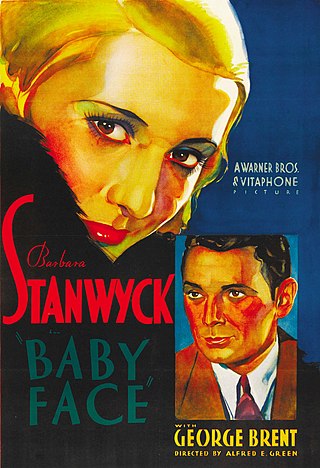
Baby Face is a 1933 American pre-Code drama film directed by Alfred E. Green for Warner Bros., starring Barbara Stanwyck as Lily Powers, and featuring George Brent. Based on a story by Darryl F. Zanuck, Baby Face portrays an attractive young woman who uses sex to advance her social and financial status. Twenty-five-year-old John Wayne appears briefly as one of Powers's lovers.

The Plastic Age is a 1925 American black-and-white silent romantic comedy film directed by Wesley Ruggles and starring Clara Bow, Donald Keith, and Gilbert Roland. The film was based on a best-selling novel from 1924 of the same name, written by Percy Marks, a Brown University English instructor who chronicled the life of the fast-set of that university and used the fictitious Sanford College as a backdrop. The Plastic Age is known to most silent film fans as the very first hit of Clara Bow's career, and helped jumpstart her fast rise to stardom. Frederica Sagor Maas and Eve Unsell adapted the book for the screen.

B. P. Schulberg was an American pioneer film producer and film studio executive.
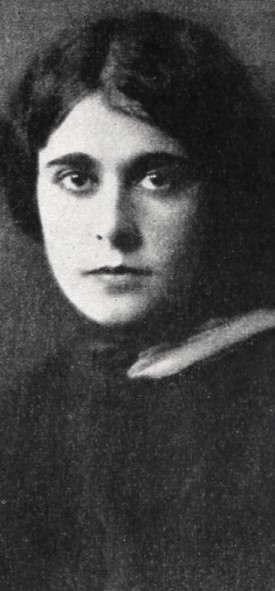
Frederica Alexandrina Sagor Maas was an American dramatist and playwright, screenwriter, memoirist, and author, the youngest daughter of Jewish immigrants from Russia. As an essayist, Maas was best known for a detailed, tell-all memoir of her time spent in early Hollywood. A supercentenarian, she was one of the oldest surviving entertainers from the silent film era.

Hoop-La is a 1933 American pre-Code drama film directed by Frank Lloyd, and starring Clara Bow, Preston Foster, Richard Cromwell and Minna Gombell also in the cast. The film is based on the play The Barker by Kenyon Nicholson, which was also filmed in 1928 under the same title as the play.

Children of Divorce is a 1927 American silent romantic drama film directed by Frank Lloyd and starring Clara Bow, Esther Ralston, and Gary Cooper. Adapted from the 1927 novel of the same name by Owen Johnson, and written by Louis D. Lighton, Hope Loring, Alfred Hustwick, and Adela Rogers St. Johns, the film is about a young flapper who tricks her wealthy friend into marrying her during a night of drunken revelry. Even though she knows that he is in love with another woman, she refuses to grant him a divorce and repeat the mistake of her divorced parents. Produced by Jesse L. Lasky, E. Lloyd Sheldon, and Adolph Zukor for the Famous Players–Lasky, the film was released on April 25, 1927 by Paramount Pictures.

Red Hair is a 1928 silent film starring Clara Bow and Lane Chandler, directed by Clarence G. Badger, based on a 1905 novel by Elinor Glyn, and released by Paramount Pictures.

Dancing Mothers is a 1926 American black and white silent drama film produced by Paramount Pictures. The film was directed by Herbert Brenon, and stars Alice Joyce, Conway Tearle, and making her debut appearance for a Paramount Pictures film, Clara Bow. Dancing Mothers was released to the general public on March 1, 1926. The film tells the story of a pretty mother, who was almost cheated out of life by a heartless husband and a thoughtless daughter. The film survives on 16mm film stock and is currently kept at the UCLA Film and Television Archive.

Three Week-Ends is a 1928 American comedy drama film directed by Clarence G. Badger and starring Clara Bow and Neil Hamilton. It is believed lost. "Three Week-Ends" is the title given in the AFI Catalog of Feature Films, with alternate titles being "Three Week Ends" and "3 Weekends".

Ritzy is a lost 1927 American comedy silent film directed by Richard Rosson and written by Elinor Glyn, Percy Heath, Robert N. Lee and George Marion, Jr. The film stars Betty Bronson, James Hall, William Austin, Joan Standing, George Nichols and Roscoe Karns. The film was released on April 9, 1927, by Paramount Pictures.
